Canadian Buildings & Exhibit at Museum in Szymbark, Poland
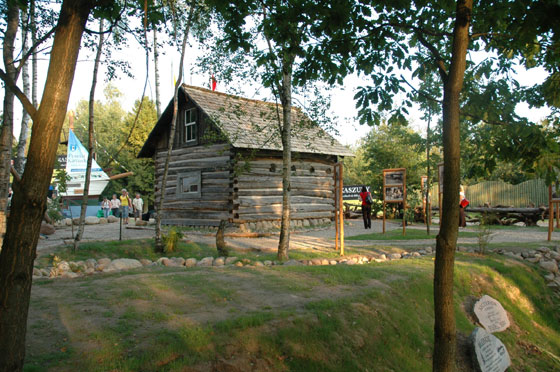
Chippior/Szczypior Building from Wilno, Canada now in Szymbark, Poland
Who would have imagined that a couple of unpretentious log buildings that survived for over a century in the Wilno hills, would now be part of a Museum exhibit in Poland? These simple structures were dismantled and then transported in a container by truck from Wilno to Montreal and then by ship to Gdansk. They reached their final destination by truck and were rebuilt in the heart of what is often called the Kashubian Switzerland— a land of rolling hills and lovely lakes, not far from the villages which were once home to Canadian Kashub emigrants.
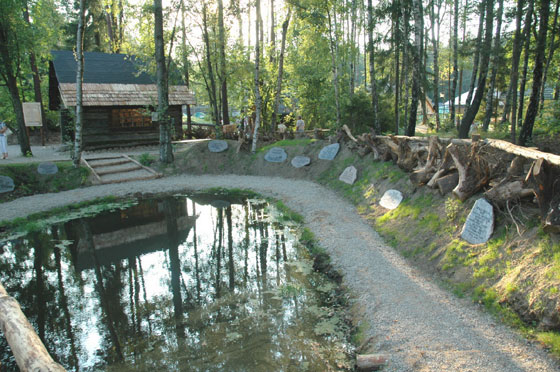
Mackwood/Machud Building from Wilno, Canada in Museum at Szymbark, Poland
Impoverished and landless farm labourers, these Kashubs had little chance of ever getting ahead in their homeland and so decided to emigrate in hopes of making a better life for their families. Their story is showcased in the exhibit at the Polish Museum [Centrum Edukaji Promocji Regionu Szymbark] and celebrated on a large stage built in the shape of a sailing ship.
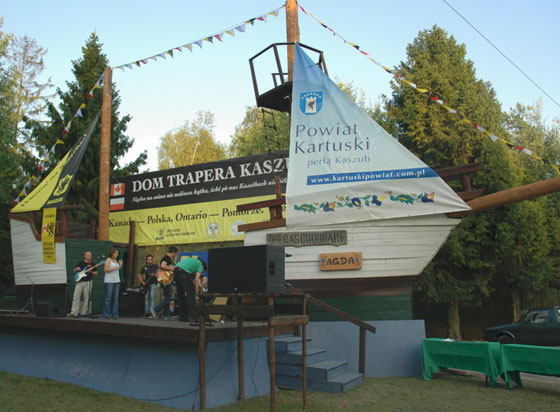
Szymbark, Poland - stage in the shape of a ship
This big Museum in the little village of Szymbark is dedicated to familiarizing visitors with the history, language and culture of Kaszuby and what happened to the Kashubs in Poland and beyond. Undoubtedly the Museum has wide appeal because of its dramatic displays and impressive claims — including the world’s longest plank and a completely unsettling “Upside Down House” symbolizing the upset caused by communism. The museum welcomes huge crowds of visitors daily and lineups are long.
The Szymbark Museum is also a showcase to wood construction. The Kashubs of Poland and Canada have great respect for the forest. Daniel Czapiewski, the creator of the museum and also owner of Danmar Wooden Houses [Domy Drewniane Danmar], whose sawmill is attached to the Museum site, visited Canada in 2008 for the 150th Anniversary of the Kashubs.
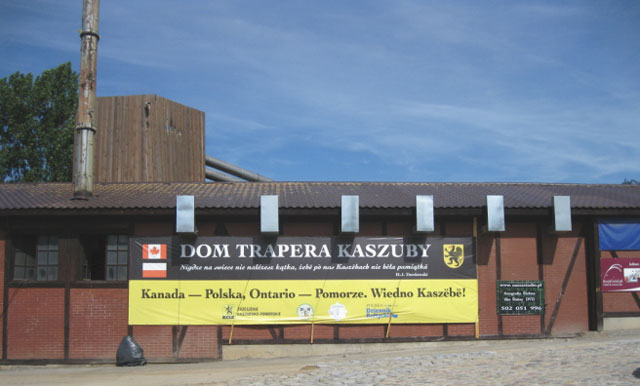
Szymbark, Poland - Danmar Sawmill next to Museum
Mr. Czapiewski was very impressed by both the pride of Canada’s Kashubs for their cultural heritage and the durable log construction of their first buildings. His wish to add a primitive house from the Canadian settlement to his Polish Museum was a year long process, facilitated by the enthusiasm and efforts of David Shulist, President of the Wilno Heritage Society with the help of the Society. The buildings were donated by Ed Chippior and Adam Shulist. To learn more about shipment of the buildings from Canada to Poland, Click Here.
The culmination of this project was a ceremonious opening in Szymbark, on August 16, 2009, with David Shulist, Ed Chippior, Shirley Mask Connolly and a number of representatives of the Wilno Heritage Society in attendance. [See Fall/Winter Newsletter V.8 N.2 for full coverage]. To see more photos from the Grand Opening August 16, 2009, Click Here.
The Chippior building is the main showpiece as an example of an original single room shelter built by one of the very first Canadian Kashub emigrant families— that of Michael Szczypior, his wife and children who left the homeland in 1858. Canadian pioneer homes were often converted into stables when they were replaced by 1½ story farmhouses built of squared logs. The original Chippior dwelling which became a stable with an enlarged door for the animals, now has been elevated to museum-worthy status.
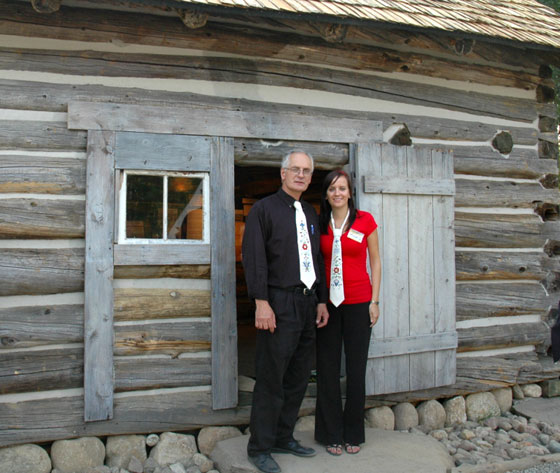
Ed & Sarah Chippior from Wilno, Canada,
in front of the Chippior Building at Szymbark, Poland.
Inside is a display of photographs of Kaszuby, Canada and Kaszuby, Poland by Jim Blomfield, Kashubian embroidery made by our Canadian elementary school students and large posters by Shirley Mask Connolly, curator of the Museum in Wilno, on the theme of “Pioneer Homes of the Kashubs in Canada” with English and Polish text.
To see more photos of the inside of the Chippior Building in Szymbark, Poland, click here.
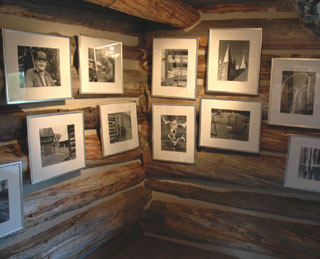 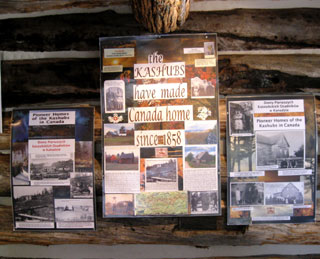
Outside, alongside a pond, there are replicas of many of the Homestead Stones that are in the Park at Wilno.
A stump puller from Canada has an important place in the Polish Park too, as does an old wooden cross.
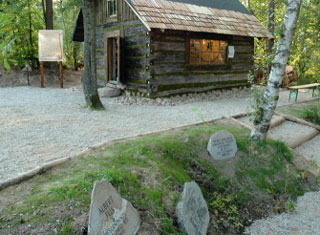
Szymbark, Poland - replicas of Heritage Stones |
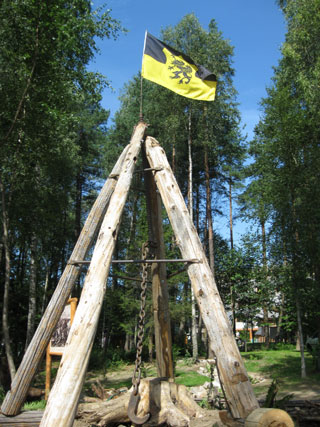
Szymbark, Poland - Stump puller from Canada |
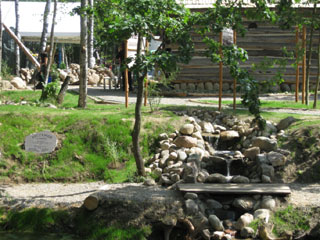 |
Black and white photographs of logging in the early days of the Ottawa Valley border a path that leads from the Chippior Building to the Mackwood Building and the Gazebo.
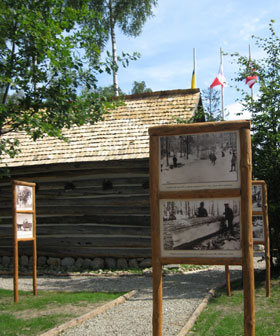 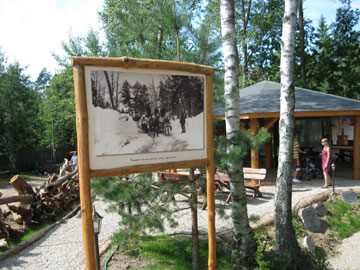
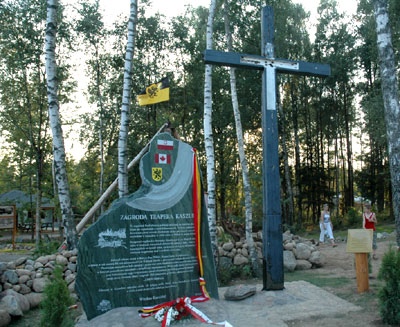 A large inscribed stone at the Museum in Szymbark titled: “Farmhouse of Kashubian Trapper /Pioneer”, with Polish, Canadian & Kashub flag/symbols: A large inscribed stone at the Museum in Szymbark titled: “Farmhouse of Kashubian Trapper /Pioneer”, with Polish, Canadian & Kashub flag/symbols:
“A wonderful homage made to Polish emigration to a far off country, where the emigrants do not forget their roots. The two antique wooden buildings were built by the first Kashubian settlers in Canada in 1858 in the area of Wilno, Ontario. The Kashubian emigrants sailed out of Hamburg and Bremen and after long months at sea in hard conditions they arrived in the new land. There they received land in the Canadian virgin forest surrounded by rocky hills and great lakes. They founded their own settlements in Barry’s Bay, Wilno, Round Lake, Combermere and even in such an appropriately names place as
Kartuzy.1 Each of the first families received 200 acres of land. The first condition was to survive and to remain on the land and build primitive houses and buildings to shelter them and their livestock. They had a hard life, working to cut down the timber and remove the stones from the soil so that they could build their houses. They were hard working, religious and determined. Today about 10,000 people with Kashubian roots live in Canada and many of them still talk excellent Kashubian. Wiedno Kaszëbë— Always Kashubian” [Translated by Stanislaw Frymark]
Inside the Mackwood stable is a display of hand imprints and wooden plaques with declarations to remind Kashubian leaders and all Kashubs around the world, to work hand in hand to preserve and protect their Kashubian cultural heritage, their language, and identity and to keep the connections alive. For more photos of the inside the Mackwood Building, click here.
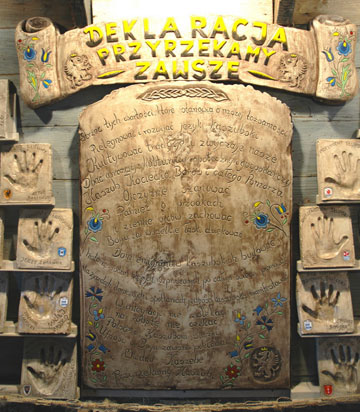 A Declaration A Declaration
We pledge
Always:
To protect these values which constitute our identity;
To nurture and develop the Kashub language;
To cultivate our traditions and customs;
To take care of the cultural, social* and economic development of Kashubia, Kociewie, Bory and all of Pomerania;
To respect the homeland;
To preserve remembrance of ancestors and the land of our fathers;
To thank God for all his mercies;
To build the Kashub emigrants’ home;
And to promote the stories of our families dispersed across the entire world;
To manifest Kashub unity at annual congresses and meetings;
To not delay integration;
To not wait for work;
To serve Poland and the Kashubs;
To always put our trust in God.
Kaszebe forever!
We pledge.
The Kashubs
(Translation Christina Zwierzchowski)
Nearby, in a spacious wooden gazebo, large colourful panels detail the story of the Kashubs in Canada with beautiful photographic images
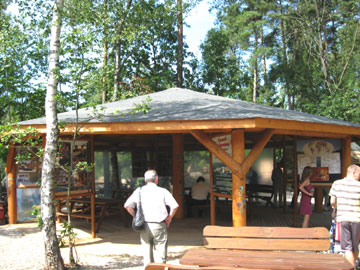 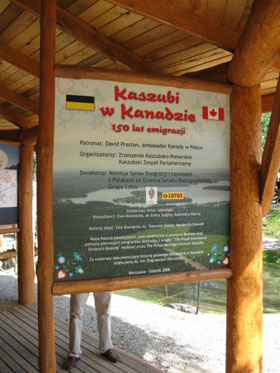
Themes include St. Stanislaus Kostka & St. Mary’s Churches, the first Polish parish in Canada, our other two Polish parishes, our first priests, first comers, pioneer cemetery, Wilno Heritage Park, Homestead Stones, Polish Kashub Heritage Museum, inside and outside, Kashub Day in Wilno, heritage trips to Poland, members of the Wilno Heritage Society, members of the Polish Heritage Institute Kaszuby, the Polish Scouts, the Cathedral in the Pines, and much more– some of you are there too! For photos of the panels in the Gazebo Display at Szymbark, click here.
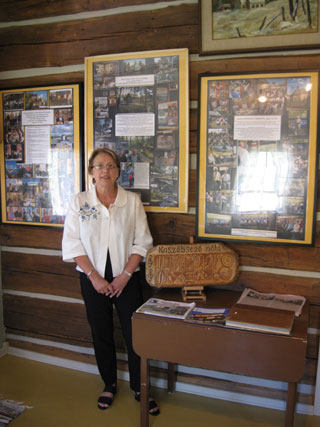 It is wonderful to have our story, past and present, told so vividly in this homeland museum and will no doubt draw visitors from here, while visitors from there, will want to come to Canada’s First Polish Settlement and Kashubian Community and learn more about our proud Polish Kashub heritage. It is wonderful to have our story, past and present, told so vividly in this homeland museum and will no doubt draw visitors from here, while visitors from there, will want to come to Canada’s First Polish Settlement and Kashubian Community and learn more about our proud Polish Kashub heritage.
To learn more about the museum in Szymbark, Poland, visit http://cepr-szymbark.pl/index.php http://cepr-szymbark.pl/index.php?dom-trapera-kaszubskiego
Don’t Miss, the Special Exhibit of Photos, Display Panels and News Clippings about the Szymbark Museum & the Canadian Exhibit in Poland at the Museum in Wilno. Also included is a large photographic panel showcasing a number of our good friends and helpers/partners in Poland.
Shirley Mask Connolly, Curator of Museum in
Wilno, Canada, in front of the Szymbark, Poland Exhibit
1Editor’s Note: actually referring to Kartuzy Lodge built by Anna and Janusz Zurakowski who were post WWII immigrants to the area.
|